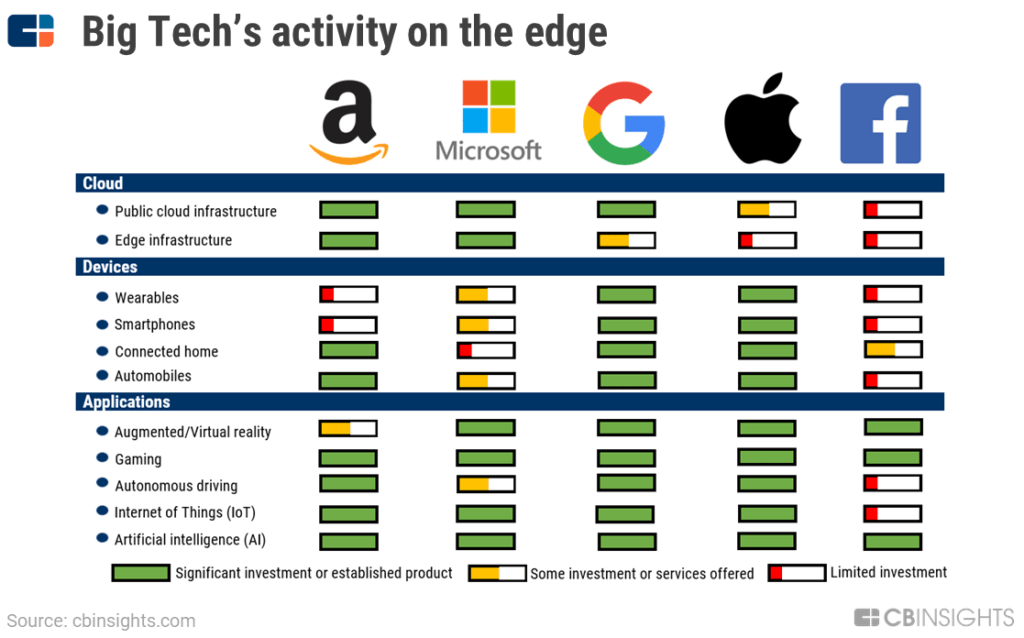With varying core competencies and sprawling businesses, each FAMGA member’s edge computing strategy is unique. Read more about each company’s approach to edge computing here.

AI at the edge allows real-time machine learning through localized processing, allowing for immediate data processing, detailed security and heightened customer experience. At the same time, many enterprises are looking to push AI into the cloud, which can reduce barriers to implementation, improve knowledge sharing and support larger models. The path forward lies in finding a balance that takes advantage of cloud and edge strengths.
…In a perfect world, we’d centralize all workloads in the cloud for simplicity and scale, however, factors such as latency, bandwidth, autonomy, security and privacy are necessitating more AI models to be deployed at the edge, proximal to the data source. Read More
Bigger is not always better for machine learning. Yet, deep learning models and the datasets on which they’re trained keep expanding, as researchers race to outdo one another while chasing state-of-the-art benchmarks. However groundbreaking they are, the consequences of bigger models are severe for both budgets and the environment alike. For example, GPT-3, this summer’s massive, buzzworthy model for natural language processing, reportedly cost $12 million to train. What’s worse, UMass Amherst researchers found that the computing power required to train a large AI model can produce over 600,000 pounds of CO2 emissions – that’s five times the amount of the typical car over its lifespan.
At the pace the machine learning industry is moving today, there are no signs of these compute-intensive efforts slowing down. Research from OpenAI showed that between 2012 and 2018, computing power for deep learning models grew a shocking 300,000x, outpacing Moore’s Law. The problem lies not only in training these algorithms, but also running them in production, or the inference phase. For many teams, practical use of deep learning models remains out of reach, due to sheer cost and resource constraints. Read More
Advance could enable artificial intelligence on household appliances while enhancing data security and energy efficiency.
Deep learning is everywhere. This branch of artificial intelligence curates your social media and serves your Google search results. Soon, deep learning could also check your vitals or set your thermostat. MIT researchers have developed a system that could bring deep learning neural networks to new — and much smaller — places, like the tiny computer chips in wearable medical devices, household appliances, and the 250 billion other objects that constitute the “internet of things” (IoT).
The system, called MCUNet, designs compact neural networks that deliver unprecedented speed and accuracy for deep learning on IoT devices, despite limited memory and processing power. The technology could facilitate the expansion of the IoT universe while saving energy and improving data security. Read More
For decades now, most data-driven innovation has taken place in centralized glass-walled rooms, data centers and mega clouds. The gravity these facilities create pulls data inward for processing, and then the resulting value is pushed back out.
Today, the world is changing, as a new digital future takes shape. We are entering an era in which the bulk of new data will be processed at the Edge, outside of corporate and cloud data centers. Read More
A way of monitoring household appliances by using machine learning to analyse vibrations on a wall or ceiling has been developed by researchers in the US. Their system could be used to create centralized smart home systems without the need for individual sensors in each object. What is more, the technology could help track energy use, identify electrical faults and even remind people to empty the dishwasher. Read More
Mobile edge computing (MEC) is an emerging paradigm that integrates computing resources in wireless access networks to process computational tasks in close proximity to mobile users with low latency. In this paper, we propose an online double deep Q networks ( DDQN) based learning scheme for task assignment in dynamic MEC networks, which enables multiple distributed edge nodes and a cloud data center to jointly process user tasks to achieve optimal long-term quality of service (QoS). The proposed scheme captures a wide range of dynamic network parameters including non-stationary node computing capabilities, network delay statistics, and task arrivals. It learns the optimal task assignment policy with no assumption on the knowledge of the underlying dynamics.In addition, the proposed algorithm accounts for both performance and complexity, and addresses the state and action space explosion problem in conventional Q learning.The evaluation results show that the proposed DDQN-based task assignment scheme significantly improves the QoS performance, compared to the existing schemes that do not consider the effects of network dynamics on the expected long-term rewards,while scaling reasonably well as the network size increases. Read More
#iot, #wifiThis article takes a look at the role of AI in IoT and the benefits of integrating the two. Blending them provides a powerful technology that can make human lives easier, businesses more effective, and provide ways to manage at global scale. Read More
The impact of artificial intelligence is starting to be realized across a broad spectrum of industries. Typically, deep learning (DL) training is a centralized datacenter process and inferencing occurs in the field. To build an AI system, data is collected, run through data scientist training models based on deep learning (DL) frameworks — on the fastest accelerated computers in the world — with the output sent to the field for an “AI at the Edge” system to inference from this model in day-to-day decision making. Read More
This blog highlights different ML algorithms used in blockchain transactions with a special emphasis on bitcoins in retail payments. This blog is structured as follows:
— Overview of the role of blockchain in the retail industry.
— Different traditional (SecureSVM, Bagging, BoostingClustering) vs deep learning algorithms (LSTM, CNN, and GAN) used in bitcoin retail payments.
Read More